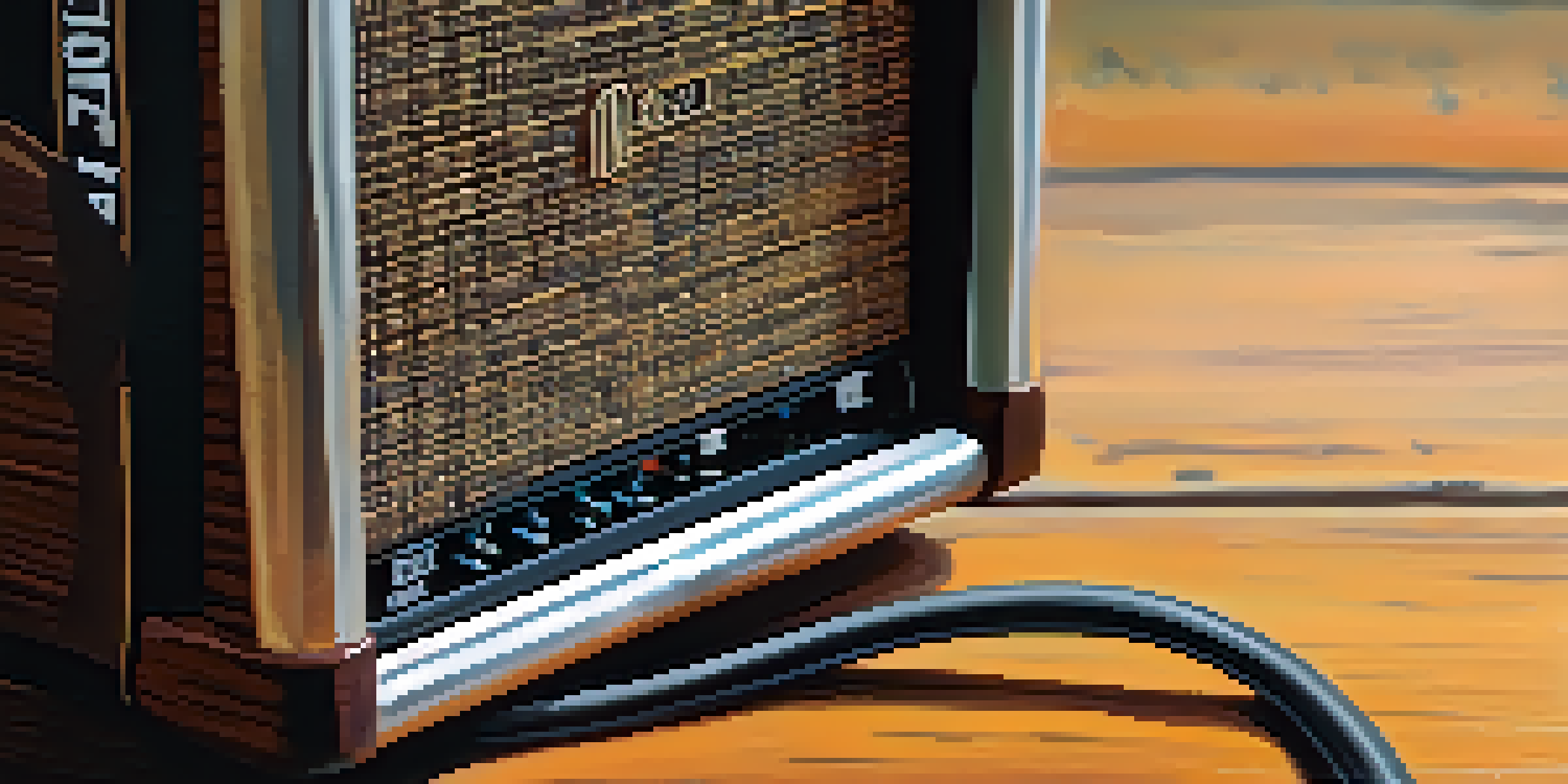The Role of DI Boxes in Guitar Recording Explained

What is a DI Box and Why is it Important?
A DI box, or direct injection box, is a device used to connect instruments, like electric guitars, directly to a sound system or recording interface. This connection can be crucial for achieving a clean and balanced sound, especially in a studio setting. By converting the high-impedance, unbalanced signal from your guitar into a low-impedance, balanced signal, DI boxes help preserve the quality of your sound, reducing noise and interference.
A good sound system is not just about the gear; it’s about how you connect it all together.
Think of a DI box as a bridge that connects your guitar to the audio world. Just like a translator helps two people speak the same language, a DI box ensures your guitar’s sound is understood by the mixing board or recording device. This is particularly important in live settings where clarity is essential, but it’s equally vital in studio recording to capture the best sound possible.
In essence, a DI box not only enhances the sound quality but also makes it easier for sound engineers to manage and manipulate the signal. This means you can focus on playing your best without worrying about the technical aspects of sound quality.
How DI Boxes Improve Sound Quality
When you plug your guitar directly into an amplifier, the signal can become distorted, especially over long cable runs. A DI box mitigates this issue by providing a clean signal that is less susceptible to interference and noise. This results in a more accurate representation of your guitar's tone during recording or live performance.

Imagine you’re trying to listen to your favorite song on a scratched record. The distortion and muddiness can ruin the experience. Similarly, a DI box ensures that your guitar's signal remains pristine, allowing every note and nuance to shine through. This clarity is essential for professional recordings where every detail matters.
DI Boxes Enhance Sound Quality
A DI box converts your guitar's signal to reduce distortion and maintain clarity, ensuring a pristine audio experience.
Additionally, DI boxes often come with built-in ground lift switches, which can help eliminate ground loop hums that might otherwise compromise your sound. This feature is particularly beneficial in complex setups with multiple devices, making it easier to achieve that polished sound you’re aiming for.
Types of DI Boxes: Passive vs. Active
DI boxes generally fall into two categories: passive and active. Passive DI boxes rely on transformers to convert the signal, making them suitable for high-impedance instruments like electric guitars. They’re simple, durable, and don’t require a power source, making them a popular choice for many musicians.
The beauty of music is in its imperfections, but a good DI box helps keep the sound clean.
On the other hand, active DI boxes use electronic circuitry and require power, either from batteries or an external source. They are typically better at handling low-impedance sources, such as keyboards or bass guitars, and can provide additional gain to the signal. This means you have options depending on your setup and instrument type.
Choosing between passive and active DI boxes often comes down to your specific needs and the characteristics of your guitar. For instance, if you’re looking for warmth and natural tone, a passive DI might be the way to go, while an active DI can help bring out the brightness and detail in your sound.
The Connection Process: How to Use a DI Box
Using a DI box is straightforward. Simply connect your guitar to the input of the DI box using a standard instrument cable. Then, use an XLR cable to connect the DI box to your mixer, audio interface, or PA system. This creates a balanced connection that helps your signal maintain integrity over longer distances.
For added versatility, many DI boxes come equipped with additional features like through outputs, which allow you to send the signal to an amplifier while also feeding it to the mixing board. This way, you can enjoy the warmth of your amp while still capturing that clean sound for recording or live performance.
Types of DI Boxes Explained
Understanding the differences between passive and active DI boxes helps you choose the right one for your instrument.
Make sure to check the settings on your DI box, as some models offer options like ground lift or pad switches, which can help you tailor the signal to your specific setup. This little bit of extra attention can make a big difference in the final sound of your recording.
Common Misconceptions About DI Boxes
One common misconception is that DI boxes are only necessary for live performances. In reality, they are equally important in the studio. Many producers and sound engineers rely on DI boxes to capture the best possible sound from electric guitars, ensuring that the recording process is as smooth as possible.
Another myth is that using a DI box will make your guitar sound artificial or stripped of its character. In fact, a good DI box enhances your guitar's natural tone rather than diminishing it. It’s all about how you use it; the right DI box can help you achieve a more authentic sound without unwanted noise.
Lastly, some believe that all DI boxes are created equal. The truth is that quality can vary significantly between models. Investing in a reliable DI box can make a world of difference in your recordings, ensuring you capture the essence of your guitar’s sound.
Integrating DI Boxes in Your Recording Setup
Integrating a DI box into your recording setup can be a game-changer. By placing a DI box between your guitar and your audio interface, you can achieve a clean and direct signal that allows for greater flexibility during mixing. This setup is particularly beneficial for tracking multiple guitar parts, as it gives you more control over the final sound.
Moreover, many musicians use DI boxes in conjunction with amplifiers. By simultaneously recording the direct signal and the mic'd-up amp, you can blend the two in post-production to create a rich, full sound. This technique is widely used in professional studios to capture the best of both worlds.
DI Boxes in Recording Setups
Integrating a DI box into your recording process allows for greater flexibility and creativity in achieving your desired sound.
Don't hesitate to experiment with different DI box placements and settings; you may discover unique tones that enhance your recordings. The beauty of using a DI box is that it opens up new possibilities for creativity in your guitar sound.
Final Thoughts: The Value of DI Boxes in Music Production
In conclusion, DI boxes play a pivotal role in both live and studio settings. They help preserve the integrity of your guitar’s sound, ensuring that every note is captured in the best possible way. Whether you’re a seasoned musician or just starting out, understanding the importance of DI boxes can elevate your recording game.
Investing in a quality DI box is not just about improving sound quality; it’s about enhancing your overall production process. With the right tools, including a DI box, you can create recordings that truly reflect your artistic vision.

So, the next time you’re setting up for a recording session or a live gig, remember the humble DI box. It might just be the unsung hero of your sound setup, helping you achieve clarity and professionalism in your music.